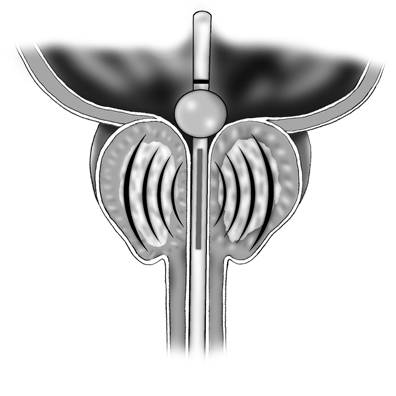BPH: Microwave Thermotherapy

Microwave Minimally invasive therapy for BPH.
Men who have symptoms from enlarged prostates have many options for treatments. The American Urological Association Guideline for treatment of BPH essentially recommended step therapy starting with medication then minimal invasive therapy followed by surgery for more refractory or advanced symptoms. Most men end up with either medical or surgical treatment but what about these in between therapies for BPH. There are many options in this treatment space and each has there benefits and deficits.
The main treatment in this category is Transurethral Microwave Thermotherapy (TUMT). This is a technology that in a controlled manner warms the lateral lobes of the prostate. Warming tissue to a certain temperature causes thermoablation of prostate tissue. If we can selective ablate tissue blocking the bladder outlet then we can open the passage allowing the urine to flow better. Typically, with improved flow come less irritative urinary symptoms.
There are many manufacturers of machinery for TUMT. This office based procedure uses a catheter that is inserted into the urethra. The anchoring balloon on the catheter is inflated once within the bladder and pulled to seat at bladder outlet. Embedded within this special catheter is an antenna at the level of the prostate that attaches to the thermotherapy control unit. A computerized warming program is then instituted. Some technologies will use a rectal probe to monitor temperature, balloons to concurrently dilate the prostatic urethra or even cycle cooled water within the catheter to keep the urethra at a lower temperature than the prostate. Warming temperature must be greater than 45 degrees Celsius for tissue ablation to occur. Different technologies target higher or lower temperatures. The temperature correlate to amount of tissue destroyed and long term outcome but also the higher the temperature the more discomfort during and longer the recovery after the procedure. Each has their slightly different techniques and the choice should optimized and patient specific.

After the procedure men can go home with a catheter for a number of days. The healing process are in many phases . Typically, the procedure will initially cause swelling of the tissue which will cause the urethral channel to narrow. Once the swelling has resolved then it is safe to remove the catheter. Along with the swelling, the tissue is irritated from the heat therapy. The body interprets this irritation as local discomfort and there can be intermittent bladder spasms as well. The urine is often colored with blood and one can see blood clots as well. Medication for these symptoms are helpful but typically do not take them fully away.
Once the catheter is removed one can see blood in the urine and experience burning during urination. There also can be urgent and more frequent urination. Over the next few weeks these symptoms will typically resolve as the prostate heals until a new baseline of urinary symptoms are reached.
